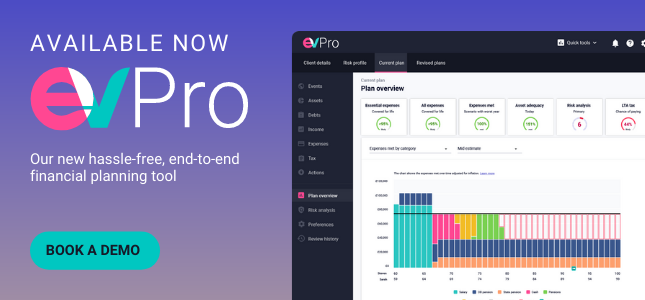As all parties involved in creating and distributing retail investments strive to get their Consumer Duty implementation plans in place by end-October, as instructed by the FCA, EV reminds the sector that its long-proven risk-rating methodology offers advice firms a useful means of complying with the Duty, in terms of delivering good client outcomes. So let’s take a look at how this works.
Looking at ‘investment’ through a retail investor’s eyes, what do we see? Putting aside the industry jargon and the complex-sounding multiple potential routes to obtaining financial prosperity in the future, we are left with this investor’s simple need: ‘What do I need to do with any spare money to get more back when I need it?’
Coming off that is a second straightforward need: ‘How can I be sure I’m doing the right thing to achieve that goal?’ Enter the financial planner, whose role is to take the client on a journey to deliver a good outcome based on their investment objective.
One of the financial planner's tasks is clearly to reassure this client that their financial interests are paramount and that the advice firm’s efforts will focus on doing their best to increase the value of the client’s investment over the long term. But unfortunately, they are quickly followed by a less positive but necessary reality check that nothing is guaranteed.
Looking at the future realistically
As is the way of the world, well grasped after a little thinking about how the future tends to unfold, what will happen to investments is just not possible to know in advance, even if some fortune tellers get things right once in a blue moon (stopped clock syndrome).
Some people believe their experience is a good guide to what might happen. Think of the global financial market of 2007/8, a decade of austerity, the Brexit upheaval, the outbreak of Covid-19, and the Ukraine-Russian conflict on our doorstep. Who could have foreseen it?
To step into an analogy, it’s best not to drive a car looking only in the rear-view mirror.
Taking risk seriously
With all this in mind, advisers and planners can prove their value by interrogating what their clients could experience in terms of risk, utilising forward-focused risk-rating methodology. With the advent of Consumer Duty, such methodology is particularly called for, given the new principles and cross-cutting rules that require an intense focus on good client outcomes and minimising harm to retail investors.
Reminder: The FCA expects all firms involved in providing retail investments to deliver good outcomes for fairly treated clients, focusing their attention on four key areas –
- products and services,
- communications,
- customer service,
- and price and value.
The rules cutting across this endeavour are ‘act in good faith towards retail customers’, ‘avoid causing foreseeable harm to retail customers', and ‘enable and support retail customers to pursue their financial objectives’.
The good news for advice firms currently pondering how best to respond to the regulator’s latest clarion call is that EV is well-versed in providing adviser tech to create rationally based forecasts of investment performance. Our risk-rating methodology has always applied a robust and realistic stochastic forecast to measure customer outcomes. And we’ve consistently applied this approach in the adviser tech we build.
Duty calls for all advice professionals
With the creation of EVPro, our one-stop tool tackling everything within the end-to-end client/adviser journey, planners have the methodology at their fingertips to determine the risk of obtaining, or not getting, the desired investment outcome. In so doing, the firm, in essence, builds an audit trail evidencing that decisions on financial plans are grounded in realism rather than hope and a following wind. This is a major win towards compliance with Consumer Duty – a must-do for advice businesses.
How this functions in practice can be demonstrated on request. In a few words, the EVPro Invest module within the tool does the crunching that provides a value projected forwards for a risk rating and its efficiency. This is then extended to the full cash flow using the EVPro Goal module, designed to take into account other more complex money flows, including tax and timing of payments. What then emerges is a range of outcomes for the client’s overall plan – at which point options can be discussed, and decisions are taken on the best way forward.
So what next?

%20(1).png)